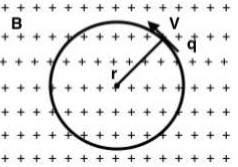Motion of Charged Particle In A Magnetic Field
Description:
If a charge ‘q’ is moving with velocity v→ enters in uniform magnetic field B→, the magnetic force acting on the particle is given by,
FB = q→V →×B →
The direction of magnetic force is same as v→×B→ if charge is positive and opposite if charge is negative.
Cases of Projection
Case I : If velocity of charge particle v→ is parallel to B→ then -

F = q V B Sin 0o ⇒ F = 0
Case II: If a charge enters a magnetic field at right angle to it, it moves in a circular path due to magnetic force which acts as a centripetal force.

Centripetal force is given by –
Where,
m = Mass of the particle,
V = Linear velocity,
r = Radius of circular path.
As we know –
FB = qVB→
Put the value of FB →
We can derive multiple relations from the above equation.
Velocity of charge
Observation: As magnetic field increases the velocity of charge increases.
Radius of circular path
Observation: To maintain the radius of circular path, as the magnetic field increases the velocity should also increase.
Angular velocity
q/m is known as specific charge.
Observation: Angular velocity depends upon the specific charge and magnetic field.
Time period of rotation
Observation: As the magnetic field increases, the angular velocity increases and time period of rotation decreases.
Frequency
Observation: As the time period of rotation increases, the frequency of rotation decreases.

